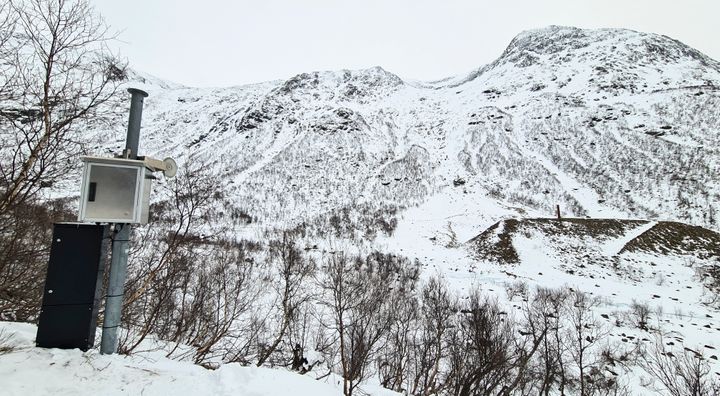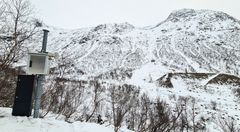Continuous avalanche measurements with new radar

Norsk versjon av artikkelen finner du her.
The new Pulse Doppler radar measures the speed of avalanches by using frequency shift. The frequency shift phenomenon in the sound of a moving object was first described by the Austrian physicist Christian Doppler. A typical example of this phenomenon is an ambulance with its sirens blaring as it approaches you at high speed. As the ambulance passes you, the sound of the siren will change pitch and become darker. The new radar will provide NGI with more information that will make it easier to monitor and research avalanches.
The radar is on loan from NGI’s partner the Austrian Research Centre for Forests (BFW).
"Until now, NGI has been using a Doppler radar that was transported into the avalanche area and manually switched on by a PC. In practice the old radar only recorded avalanches triggered by us. This was because it was not possible to leave it on except when performing our planned measurement campaigns, says Senior Avalanche and Rockslide Specialist," Dr Peter Gauer.
The new radar is operational 24/7 throughout the winter and will also detect avalanches occurring naturally.
Developed and tested in Austria
The radar was developed, built, and tested in Austria. It will record the speeds of avalanches at different points along the avalanche path.
“With the new radar we are hoping to obtain more and better speed measurements. These will, among other things, be important for the development and validation of numerical avalanche models. From a Health and Safety perspective, we will no longer have to enter exposed terrain in order to obtain measurements," says Dr Gauer.
New weather station and scanner for snow depth
In addition to the new radar, a compact weather station and LIA laser scanner have been purchased. The laser scanner measures growth in snow height from snowfall or wind-drifted snow. The scanner can also provide information about the fracture heights in the release area.
The scanner is mounted on the Wyssen avalanche tower above Ryggfonn’s release area. The instruments will provide better details about weather parameters and snowpack in the release area, for example, the actual initial avalanche volume.
“This will make it easier to choose a good time for initiating a measurement campaign. A new weather station near the instrument cabin in Grasdalen is providing additional measurements. Our weather stations will also help us to better understand how the weather and snow properties affect avalanche activity and avalanche dynamics," says Dr Gauer.
To view this piece of content from www.youtube.com, please give your consent at the top of this page.
Research for the future
The aim of NGI's avalanche research at Ryggfonn is the development of better tools for hazard zone mapping, which constitutes a part of land use planning that helps to delimit where infrastructure can be established safely without being exposed to avalanches. It is therefore important to have as much information as possible about avalanche behavior in order to be able to assess potential hazard in planned development areas.
“Before our last experiment on April 11, a few smaller natural avalanches were recorded by our new Doppler radar. All the data from the experiment and naturally triggered avalanches will now be evaluated during the summer. It is important that we obtain more measurements of different snow conditions and enough repetitions to enable generalisation of the results," says Dr Gauer.
Parts of this research are being funded by the Norwegian Ministry of Petroleum and Energy under the "R&D Avalanche 2020-2023" project grant awarded to NGI and administered by the Norwegian Water Resources and Energy Directorate (NVE).
Keywords
Contacts
Henrik LangelandProject engineer IAvalanches and Rock Slides
Tel:+47 971 96 730henrik.langeland@ngi.noPeter GauerSenior SpecialistAvalanches and Rock Slides
Tel:+47 452 74 743peter.gauer@ngi.noImages

About NGI
På sikker grunn
NGI – Norges Geotekniske Institutt – er et uavhengig, internasjonalt senter for forskning og rådgivning innen ingeniørrelaterte geofag, der vi integrerer kunnskap mellom geoteknikk, geologi og geofysikk. Vår forskning gir kunnskap som styrker norsk næringsliv til å løse noen av de viktigste utfordringene vi står overfor innenfor klima, miljø, energi og naturfarer.
Gjennom årene har vi tiltrukket oss dedikerte fagfolk og internasjonale eksperter på bruk av geomaterialer som byggegrunn og byggemateriale, skredproblematikk og forurensning av grunnen. Utvikling og anvendelse av ny teknologi står helt sentralt i vår virksomhet for å finne bærekraftige løsninger og sikre at vi bygger et samfunn på sikker grunn. Vår ekspertise og løsninger er kjent og etterspurt i store deler av verden.
NGI har hovedkontor og laboratorier i Oslo, avdelingskontor i Trondheim, forskningsstasjon for snøskred på Strynefjellet, og utenlandskontorer med geoteknisk laboratorium i Houston, Texas, USA, og i Perth, Western Australia, i tillegg til samarbeidsavtaler med veletablerte selskap og institusjoner i store deler av verden.
NGI ble formelt opprettet 1. januar 1953, underlagt Norges Teknisk-Naturvitenskapelige Forskningsråd (NTNF). I 1985 ble NGI omgjort til en selvstendig stiftelse. Driftsvirksomheten (forskning og rådgivning) ble 1. januar 2024 overført til Norges Geotekniske Institutt AS, et aksjeselskap som eies 100 % av stiftelsen NGI.
Som en av hovedpartnerne støtter NGI Ingeniører Uten Grenser (IUG) økonomisk og gjennom å bidra med ingeniørkompetanse til IUGs oppdrag for norske bistandsorganisasjoner.
Subscribe to releases from NGI
Subscribe to all the latest releases from NGI by registering your e-mail address below. You can unsubscribe at any time.
Latest releases from NGI
Global modell skal gjøre verden bedre rustet mot tsunamier17.11.2025 11:46:45 CET | Pressemelding
Da en enorm flodbølge traff kystene rundt Indiahavet andre juledag i 2004, mistet mer enn 220 000 mennesker livet. Det var en katastrofe som rystet verden og som avslørte hvor lite vi egentlig forsto om tsunamier.
NGI-forsker valgt inn i styret til European Chemicals Agency (ECHA)24.10.2025 12:15:11 CEST | Pressemelding
Forsker ved NGI - Norges Geotekniske Institutt, Hans Peter Arp, er én av verdens fremste eksperter på kjemisk forurensning. Nå skal miljøkjemikeren påvirke kjemikaliepolitikken i Europa.
NGI lanserer unikt traineeprogram innen geoteknikk30.9.2025 09:11:00 CEST | Pressemelding
Fire nyutdannede ingeniører får nå muligheten til å prøve seg på tvers av NGIs kjerneområder. Gjennom et nytt traineeprogram skal de utforske alt fra fundamentering på land til havvind og klimatilpasning.
Flere velger geoteknikk og kvinneandelen skyter i været11.9.2025 08:55:38 CEST | Pressemelding
Masterstudiet i geoteknikk ved OsloMet vokser raskt. Da studiet startet i 2022, var det fem studenter og bare menn. Denne høsten har 21 nye studenter startet, av dem åtte kvinner.
Vi kan bygge tryggere tunneler med kunstig intelligens15.8.2025 14:51:34 CEST | Pressemelding
Kunstig intelligens endrer hvordan vi bygger tunneler. Vi kan forutsi farlige forhold i berget før vi treffer dem. Det gir tryggere tunneler, lavere kostnader, mindre naturinngrep og bedre beslutninger under bakken.
In our pressroom you can read all our latest releases, find our press contacts, images, documents and other relevant information about us.
Visit our pressroom
